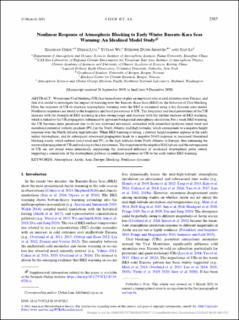Nonlinear response of atmospheric blocking to early Winter Barents-Kara seas warming: An idealized model study
Journal article, Peer reviewed
Published version

Åpne
Permanent lenke
https://hdl.handle.net/11250/2990869Utgivelsesdato
2021Metadata
Vis full innførselSamlinger
- Geophysical Institute [1198]
- Registrations from Cristin [9791]
Sammendrag
Wintertime Ural blocking (UB) has been shown to play an important role in cold extremes over Eurasia, and thus it is useful to investigate the impact of warming over the Barents–Kara Seas (BKS) on the behavior of Ural blocking. Here the response of UB to stepwise tropospheric warming over the BKS is examined using a dry dynamic core model. Nonlinear responses are found in the frequency and local persistence of UB. The frequency and local persistence of the UB increase with the strength of BKS warming in a less strong range and decrease with the further increase of BKS warming, which is linked to the UB propagation influenced by upstream background atmospheric circulation. For a weak BKS warming, the UB becomes more persistent due to its less westward movement associated with intensified upstream zonal wind and meridional potential vorticity gradient (PVy) in the North Atlantic mid-high latitudes, which corresponds to a negative height response over the North Atlantic high latitudes. When BKS warming is strong, a positive height response appears in the early winter stratosphere, and its subsequent downward propagation leads to a negative NAO response or increased Greenland blocking events, which reduces zonal wind and PVy in the high latitudes from North Atlantic to Europe, thus enhancing the westward propagation of UB and reducing its local persistence. The transition to the negative NAO phase and the retrogression of UB are not found when numerically suppressing the downward influence of weakened stratospheric polar vortex, suggesting a crucial role of the stratospheric pathway in nonlinear responses of UB to the early winter BKS warming.